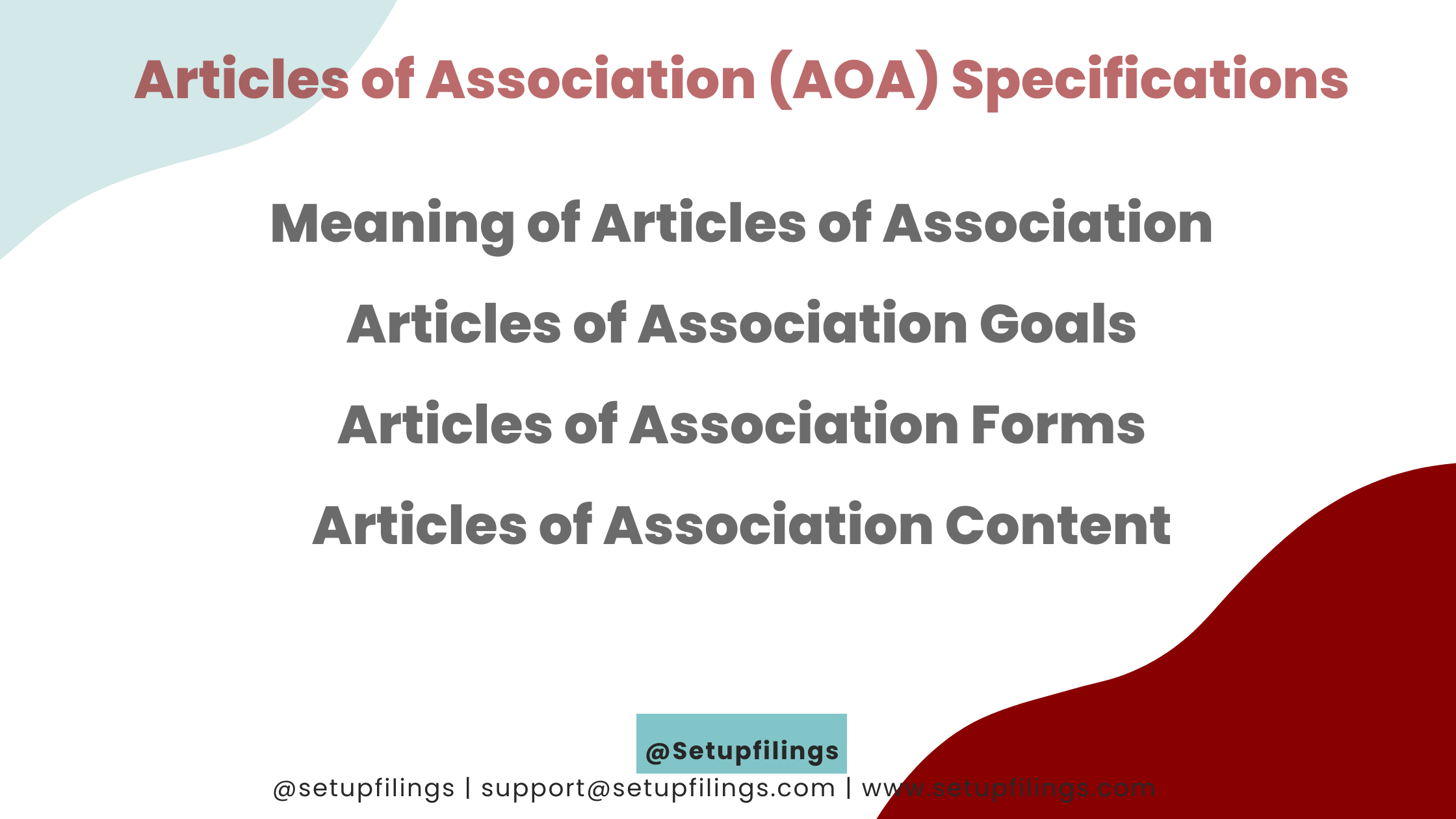
Articles of Association (AOA) Specifications
A company’s Memorandum of Association (MOA) and Articles of Association (AOA) are two key commercial papers. Every business requires a set of rules and regulations to govern its internal affairs, and the AOA describes the firm’s internal regulations. Simply put, the Aoa Companies act 2013 comprises the company’s bye-laws, which govern how the director and other members must carry out their duties.
In this article, we will go over the articles of association companies act, 2013, under company law, the status of the articles of association companies act 2013, and how the firm’s connection with the outside world is defined and governed by the AOA in detail:
Meaning of Articles of Association (AOA)
According to Section 2(5) of the Companies Act, 2013, articles refer to a company’s Articles of Association in company law (AOA in company law) that were initially written, changed, or applied in accordance with any prior company legislation or this Act.
Articles of Association Goals (AOA)
• The AOA of the firm must include the company’s management rules, as well as such other issues as may be specified.
• Moreover, it shall not preclude a firm from putting in its AOA any additional elements deemed relevant for its administration.
Articles of Association Forms (AOA)
Tables F, G, H, I, and J of Schedule I of the Companies Act, 2013 provide Articles of Association (AOA) forms for several kinds of businesses. Also, AOA must be in the appropriate form.
| S.No | Table | Form |
| 1 | Table F | Articles of Organization of a Company Limited by Shares under the Companies Act 2013 |
| 2 | Table G | Articles of Organization of a Limited Liability Company with Share Capital |
| 3 | Table H | Articles of Organization of a Limited Liability Company with No Share Capital |
| 4 | Table I | Articles of Organization of a Limited Liability Company with Share Capital |
| 5 | Table J | Articles of Organization of an Indefinite Company with No Share Capital |
A corporation may implement all or some of the rules provided in the model Article, depending on their relevance.
In the case of any company registered after the commencement of this Act, insofar as the registered AOA of such company does not exclude or modify the regulations contained in the model AOA, those regulations shall be the regulations of that company in the same manner and to the same extent as if they were contained in the company’s duly registered AOA, where applicable.
Articles of Association Content (AOA)
An AOA covers the rules and regulations for the following topics:
• Share capital including sub-division, rights of individual shareholders, their relationships, share certificates, and commission payments.
• Shares lien: To keep or keep ownership of shares if a member is unable to pay his obligation to the firm.
• Calls on shares: A call on share is an unpaid portion of a share that must be paid by the shareholders upon the company’s demand.
• Share transfer: The AOA includes the mechanism for transferring shares from a shareholder to another person (transferee).
• Shares transmission: This includes title devolution via succession, death, marriage, bankruptcy, and so forth.
• Share forfeiture: The AOA allows for the loss of shares if the acquisition criteria, such as paying call money, are not satisfied.
• Share surrender: Share surrender occurs when shareholders voluntarily give back or return the shares they possess to the corporation.
• Stock conversion: In accordance with the Articles of Association, the firm may convert the shares into stock by an ordinary decision at a general meeting.
• Share warrant: A share warrant is a bearer document pertaining to the title of shares that may only be issued by Public Limited Company; Private Limited Company firms cannot issue share warrants.
• Capital alteration: Capital must be increased, decreased, or rearranged in accordance with the Articles of Association.
• General meetings and proceedings: The Articles of Association must include all requirements pertaining to general meetings and how they are to be conducted.
• Voting rights of members, voting by poll, proxies: The Articles of Association specify the members’ right to vote on particular business affairs and the method of voting.
• Directors, their appointment, salary, qualifications, powers, and board of directors meeting processes.
• Dividends and reserves: A company’s Articles of Association also allow for the payment of dividends to shareholders.
• Accounting and Audits: The auditing of a company is subject to the terms of the firm’s Articles of Association.
• Borrowing Powers: Every business has the ability to borrow. Nonetheless, this must be done in accordance with the company’s Articles of Association.
• Winding Up: Regulations pertaining to the winding up of the company are included in the company’s articles of association and must be followed.
What is the difference between a Memorandum of Agreement and an Articles of Association?
| Parameters | MOA | AOA |
| Objectives | It establishes a company’s goals. It also establishes the terms of incorporation. | It covers the company’s internal management rules and regulations, as well as bye-laws. |
| Relationship | It describes the company’s interaction with the outside world. | It specifies the members and the company’s relationship. |
| Alteration | It can only be changed in exceptional situations. | It may be changed by passing a special resolution. |
| Ultra-Vires | Any actions that go beyond the scope of the MOA are ultra-vires and null and void. Consequently, even unanimous votes from all shareholders in favor of such an act cannot confirm it. | Actions that violate the AOA might be approved by a special resolution of the shareholders. Such behaviors, however, should not violate the MOA. |
Visited 126 Times, 1 Visit today
